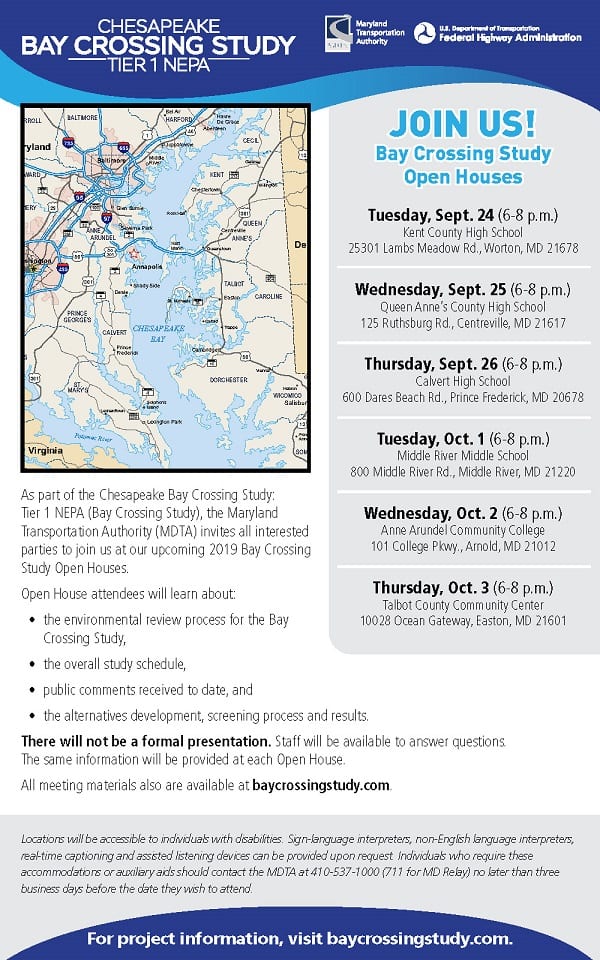MIDDLE RIVER, MD – As part of the ongoing Chesapeake Bay Crossing Study, four preliminary alternatives will be presented to the public this fall.
Thus far, data has shown that these preliminary corridor alternatives are the only corridors to sufficiently meet the purpose and need in accordance with the National Environmental Policy Act (NEPA), according to the Maryland Transportation Authority. As part of this process, the MDTA will present these alternatives to the public at six open houses in September and October.
“While the No-Build alternative and three preliminary corridor alternatives are being included in the federal environmental process for further study, traffic models indicate that one of the three, building a third crossing within the same corridor as the existing Bay Bridge (Corridor 7), would have the most positive impact on reducing traffic,” said MDTA Executive Director Jim Ports.
The MDTA and Federal Highway Administration (FHWA) are following a tiered NEPA process that provides a systematic approach for advancing potential transportation improvements. The purpose of the Chesapeake Bay Crossing Study is to consider potential alternatives to provide expanded traffic capacity and additional access across the Chesapeake Bay.
The study also looks at alternative transportation methods including ferry service, bus rapid transit, rail transit, and transportation systems management/travel demand management.
The Bay Crossing Study Tier 1 is retaining the No-Build alternative and these Preliminary Corridor Alternatives Retained for Analysis (CARA):
- Corridor 6: MD 100 to US 301 between Pasadena (Anne Arundel County), Rock Hall (Kent County) and Centreville (Queen Anne’s County);
- Corridor 7: existing Bay Bridge corridor, US 50/301 to US 50 between Crofton (Anne Arundel County) and Queenstown (Queen Anne’s County); and
- Corridor 8: US 50/301 between Crofton (Anne Arundel County) and Easton (Talbot County).
Data indicates, according to the MDTA, that each of the three corridor alternatives could have a positive impact on traffic. Officials say that Corridor 7, the corridor where the existing Bay Bridge is today, provides the most congestion relief.
Following the Tier 1 study, a Tier 2 study would identify specific alignment alternatives within the corridor alternative that is identified in Tier 1.
At the open houses, the MDTA will provide information and receive feedback on the range of alternatives and the Preliminary CARA. Attendees also will learn about the purpose and need aspect of the study, traffic, engineerin,and environmental considerations, comments received to date, next steps, and how to stay informed. For more information on the four preliminary alternatives, visit baycrossingstudy.com to review the public open house display boards.
The planned open houses are as follows:
| Tuesday, Sept. 24 (6-8 p.m.)
Kent County High School 25301 Lambs Meadow Rd. Worton, MD 21678 |
Wednesday, Sept. 25 (6-8 p.m.)
Queen Anne’s County High School 125 Ruthsburg Rd. Centreville, MD 21617
|
| Thursday, Sept. 26 (6-8 p.m.)
Calvert High School 600 Dares Beach Rd. Prince Frederick, MD 20678
|
Tuesday, Oct. 1 (6-8 p.m.)
Middle River Middle School 800 Middle River Rd. Middle River, MD 21220 |
| Wednesday, Oct. 2 (6-8 p.m.)
Anne Arundel Community College 101 College Pkwy. Arnold, MD 21012
|
Thursday, Oct. 3 (6-8 p.m.)
Talbot County Community Center 10028 Ocean Gateway Easton, MD 21601 |
Funded by toll dollars, the Bay Crossing Study Tier 1 began in 2016 and is expected to be complete in 2021.
The next steps are to publish a Draft Environmental Impact Statement and hold public hearings in fall 2020.
The final steps are to identify the preferred corridor alternative and publish the Final Environmental Impact Statement/Record of Decision in collaboration with FHWA in summer 2021.
Do you value local journalism? Support NottinghamMD.com today.

